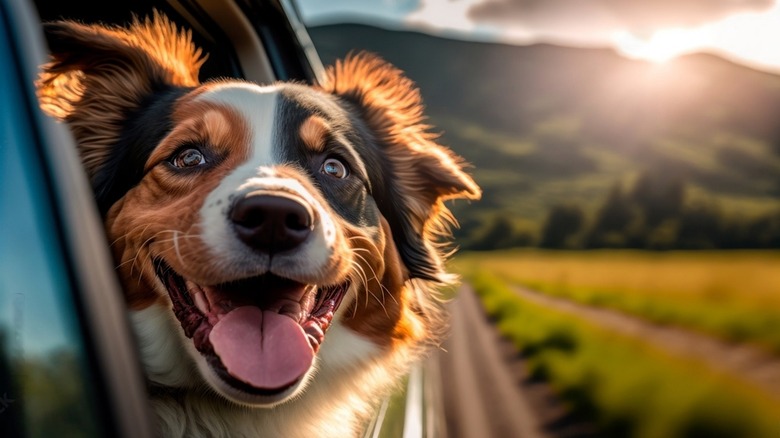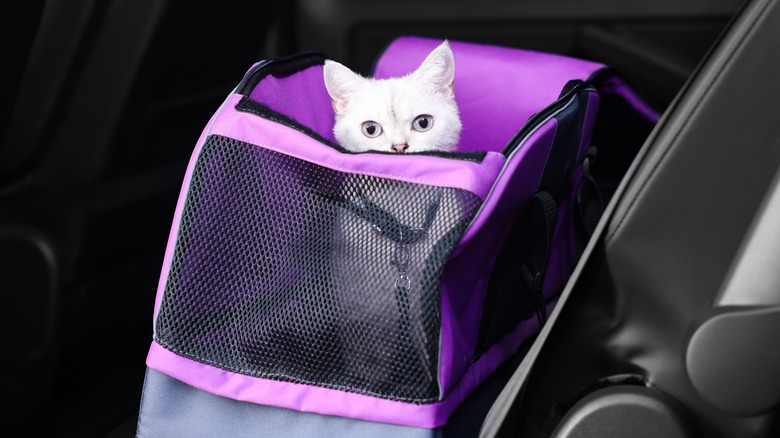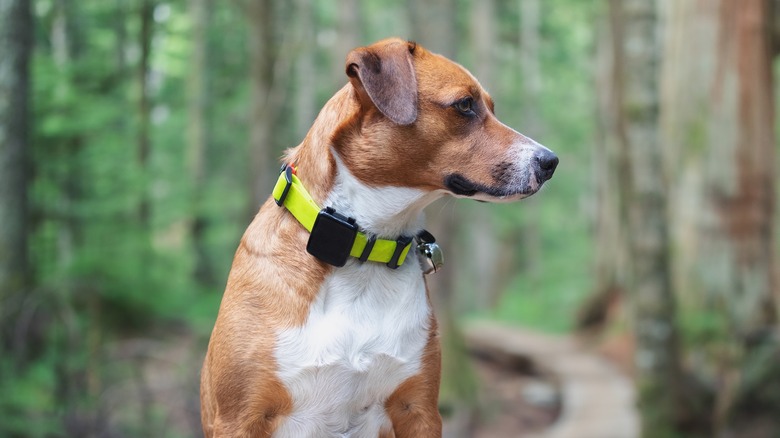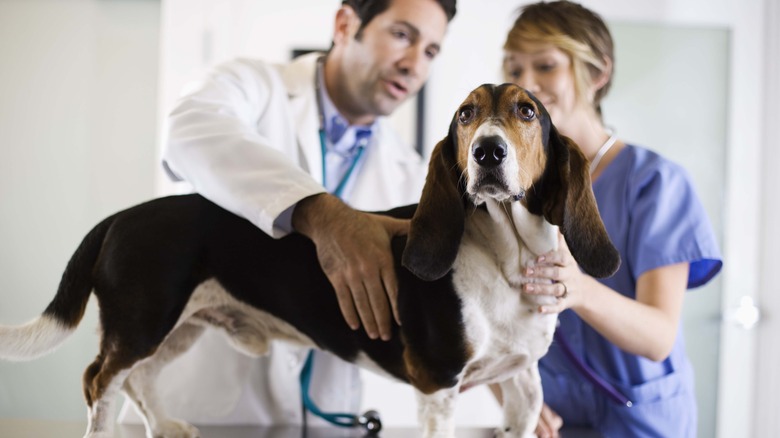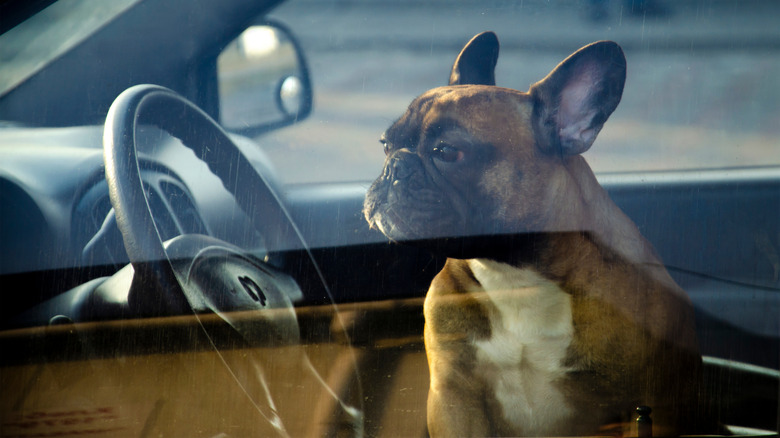5 Tips To Keep Your Pet Comfortable During Long Drives
We may receive a commission on purchases made from links.
For a growing number of people, pets are treated like family, and we do our best to give them a great life. With some animals living up to several decades at a time, it's unsurprising that some of them become lifelong companions for pet lovers.
In its 2023-2024 National Pet Owners Survey, the American Pet Products Association (APPA) shares that 66% (86.9 million) of households in the United States own a pet. Not only that, the APPA also claims that Americans spent a total of $136.6 billion on their pets in 2022 (via Forbes). With an increasing number of people getting pets each year, this number will likely only be higher in the years to come.
Among the many ways that pet owners are looking to spend on their pets is through travel. According to Forbes, millions of people choose to bring their pets while traveling, leading to a rise in pet-friendly travel experiences and accommodations. If you're a pet parent who is looking to take your pet on a trip, there are endless resources at your disposal for planning a trip with your animal companion, from luxury pet resorts to pet-friendly Airbnb listings.
However, there are some challenges you need to overcome before getting there, especially when it comes to traveling on the road. Thankfully, with the right planning, you can do plenty of things before and during the trip that can make traveling more comfortable for you and your pet.
Invest in car seats
Having the right car seat for your pet can not only help prevent accidents but also help keep your car clean. These days, many pet car seats include waterproofing, scratch-proofing, and clasps that you can attach to your pet's harness. Typically, they're also easily removable so that you can transfer them from one car to another.
If you have a large dog and a big enough car to accommodate it, the Nzonpet 4-in-1 Dog Car Seat Cover ($46.99) can give your dog enough space to remain comfortable throughout a long drive. However, if you have a smaller animal or those with breathing issues, you may want an elevated car seat, such as the SWIHELP Dog Car Seat ($16.89), which also features clip-on safety leashes and anti-collapse features.
On the other hand, cat owners may opt for enclosed safety carriers like the K&H Pet Products Safety Carrier ($90.99), which can help them feel safer and keep them from jumping around the vehicle when they get scared.
Although, when it comes to car seats, you'll likely experience a few rips and tears, especially when pets are involved. They can also get bigger quickly if you don't repair them immediately. So, if you know you'll be on the road for a while and don't want to spend thousands of dollars, you can prepare for your road trip by buying repair kits for your car seats ahead of time.
Invest in a pet tracker
Pet trackers are a must if you're planning to make stops in areas like mountains, trails, or forests because they can give you peace of mind if you're ever separated from your pet. Although many people will opt for trackers like the AirTag, they're not necessarily the best option when it comes to pet-specific features. By buying a tracker or collar designed for pets, you not only have more relevant features, such as health tracking or geo-fencing, but you can rest assured that they're built to be able to withstand exposure to the elements.
When choosing a pet tracker for an interstate road trip, some key things to consider include the fit, battery life, and distance tracking capabilities. Typically, pet trackers are designed to fit the average pet, so if you have a relatively smaller or larger pet, you may need to get creative with how you attach them. In some cases, pet trackers also rely on things like other phones, data connection, and so on, which may not be useful if you're traveling to off-grid areas. Not to mention you should also get a tracker that has enough battery life to last the length of your trip, or you'll need to be mindful of charging it regularly.
Aside from a pet tracker, you should also consider microchipping your pet (if possible) and wearing a collar with a legible ID tag to increase the chances of finding it if it ever gets lost.
Consult a veterinarian
Before bringing your pet on the road, you should definitely consult with a veterinarian and make sure their vaccinations are up-to-date. Aside from helping protect them against illness, the American Veterinary Medical Foundation (AVMF) mentions that it is required to secure a certificate of veterinary inspection (CVI), which you may need when entering certain states.
In some states, such as Hawaii, a law also requires dogs and cats to be in quarantine for up to 120 days. To avoid additional stress at the borders, check these laws ahead of time so you can either avoid the states that have these requirements or comply with requirements that would exempt your pet from long-term quarantine procedures.
In some cases, vets can also prescribe calming medication, which can be used to help temper your pet's travel anxiety. Before prescribing, your pet's vet may require behavioral evaluations, suggest alternative calming methods, and request a checkup and/or bloodwork. This is because some calming medications are not recommended for pets with other health conditions, such as diabetes and epilepsy. Other times, you may need to give small dosages to your pet several weeks before your trip.
Additionally, learning basic lifesaving skills like first aid and CPR for pets can help give you peace of mind in the event of an emergency. So, if you're already at the vet, you should ask them how to properly do these things on your pet.
Maintain the right temperature
Depending on the kind of pet you have, they may have a preferred temperature that is comfortable for them. For example, when a dog's internal body temperature reaches 105 degrees Fahrenheit and above, the American Kennel Club says it could suffer a heatstroke. Although all dogs can experience heatstroke, it cites some factors that can make some animals more prone to it, such as breed, age, weight, and physical fitness.
In warmer weather, the American Veterinary Medical Association (AVMA) cautions pet owners that idle cars can reach up to 140 degrees Fahrenheit in less than an hour, which could be lethal to many pets. On the other hand, it's recommended to never leave your pet alone in the car, especially when temperatures are below 50 degrees Fahrenheit. When a pet's internal temperature drops to 98 degrees Fahrenheit, it can lead to hypothermia.
Knowing all of this, it's no wonder that several states (PDF) have strict laws against leaving an animal unattended inside a vehicle. So, if you're planning to travel without another human in your car throughout these areas, you have to make sure to bring your pet with you every time you make a stop.
When traveling with multiple people or pets, ideal temperatures may also vary. Aside from strategically seating people or pets near your air conditioner, you can also create varying temperature zones in your car by buying cooling or healing mats and portable fans.
Make time for bathroom breaks
Similar to humans, your pets will also need bathroom breaks throughout the duration of your trip. This can be mitigated for litter-trained pets like cats by having a portable litter box, which you can bring with you in the car. However, for larger pets like dogs, you'll need to factor in pet-friendly stops wherein they can do their business.
Since each pet is different, you'll need to pay attention to how often your pet typically needs to use the restroom in your home. In general, it's recommended that bathroom breaks occur every two to four hours, but you may need to do it more often under special conditions. Younger animals, like puppies, older pets, or pets with medical conditions, may need more frequent breaks than healthy adult pets.
Alternatively, if your pet is comfortable with diapers, you can make them wear them in between stops to avoid accidents. Depending on your needs, you can either get reusable diapers or disposable ones. Although, it's important to bear in mind that it can potentially cause urinary tract infections (UTIs) if not changed regularly enough. To prevent unwanted infections, changing a dog's diaper every two to four hours is best.
However, bathroom breaks don't need to be boring. You can enjoy the scenery while you're at it by integrating interesting pet-friendly bathroom stops, such as grassy areas or community parks. Regular breaks can also help pets who experience motion sickness calm down.
Make road trips with your pet more enjoyable
Despite being perceived as common pets, some animals, like flying squirrels, rabbits, quails, opossums, and ferrets, are considered captive wildlife. So, if you're traveling across states within the United States with them, it's important to check local regulations for requirements and restrictions.
In addition, depending on the states you'll be visiting or even just passing by, the laws for owning, possessing, or transmitting animals will vary. To make sure you have all the necessary documentation for each leg of your trip or if you're not sure if your specific pet is classified under the captive wildlife category, you can consult with your state wildlife management agency.
Suppose you're on a one-way road trip to your next permanent home. In that case, you may consider using a pet shipper member of the International Pet and Animal Transportation Association (IPATA). Alternatively, if a road trip is not completely necessary, you can even consider flying on an airplane with your pet instead. Under certain circumstances, some airlines accept pets in their cabins, which can lead to a shorter and more straightforward travel experience.
Lastly, if you bring your pet on the road, you may want to invest in cleaning tools to keep pet hair at bay. And don't forget to bring a pack of baking soda with you to keep your car seats smelling fresh, even after hours (or days) on the road with your pet.
